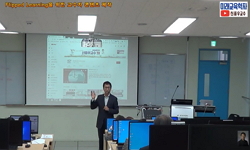本硏究では、韓國語母語話者4名の日本語によるフォ一マルな談話資料を材料として用いて、文末のノダ形式と終助詞の習得の樣相を分析した。その後、學習者HT氏に焦点を絞り、習得期(2...
http://chineseinput.net/에서 pinyin(병음)방식으로 중국어를 변환할 수 있습니다.
변환된 중국어를 복사하여 사용하시면 됩니다.
- 中文 을 입력하시려면 zhongwen을 입력하시고 space를누르시면됩니다.
- 北京 을 입력하시려면 beijing을 입력하시고 space를 누르시면 됩니다.

日本語學習者におけるノダ形式および終助詞の習得と維持 -クラッシェンのインプット反說の觀点から- = Acquisition and Maintenance of Noda and Final Particle Sentences in Japanese: Applying Krashen`s Input Hypothesis
한글로보기https://www.riss.kr/link?id=A102131933
- 저자
- 발행기관
- 학술지명
- 권호사항
-
발행연도
2016
-
작성언어
Korean
-
주제어
文末表現 ; ノダ形式 ; 終助詞 ; 習得 ; 維持 ; インプット反說 ; sentence-final expression ; noda form ; sentence-final particle ; learning ; maintenance ; Input hypothesis
-
등재정보
KCI등재
-
자료형태
학술저널
-
수록면
33-51(19쪽)
- 제공처
-
0
상세조회 -
0
다운로드
부가정보
다국어 초록 (Multilingual Abstract)
本硏究では、韓國語母語話者4名の日本語によるフォ一マルな談話資料を材料として用いて、文末のノダ形式と終助詞の習得の樣相を分析した。その後、學習者HT氏に焦点を絞り、習得期(2001年-2002年)の談話資料と、歸國後の約10年經った維持期(2012年-2014年)の計6回の談話資料を分析し、習得と維持の兩面について、クラッシェンのインプット反說の觀点から分析した。その結果は、次のようにまとめられる。まず、學習者は、日本語の文末表現を「言い切りの文→終助詞付加文→ノダ形式付加文→ノダ形式と終助詞付加文」の順序で積み上げ式の習得を行い、特にノダ形式付加文は過去形に接續して用いる。それは李吉鎔(2010)が明らかにした、丁寧體において活用が難しくなる環境で形態的手續きの複雜な〈マス形式〉を回避し、普通形に機械的に〈ンデス〉をつけていくといった簡略化の結果である。次に、HT氏についてクラッシェンのインプット反說を參照すると、〔習得期〕は「i+1」の途中にあり、「+1」を積極的に使用する段階であると考えられる。HT氏の〔習得期〕における「i」は、言い切りの文とノダ形式付加文であり、「+1」は終助詞付加文と、ノダ形式と終助詞付加文であると考えられる。そして、新しい習得が行われないHT氏の〔維持期〕においては、「i」は言い切りの文とノダ形式付加文、終助詞付加文とノダ形式+終助詞付加文のすべてであり、「+1」の事象は存在しないことになる。最後に、第2言語の維持や摩滅の觀点からは、HT氏の〔維持期〕は磨滅が起こっていると考えれば、「i-1」の狀態になる。ここで「-1」は終助詞付加文と、ノダ形式と終助詞付加文である。HT氏の〔習得期〕は、ノダ形式と終助詞付加文の過剩般化による獨自體系の構築期(+1の段階)にあたるため、〔維持期〕においては獨自體系の構築が緩和されたものと考えられる。
다국어 초록 (Multilingual Abstract)
This research analyzes the acquisition of noda and other final particles in Japanese observed in formal speech of four Korean learners. In this paper, we will particularly focus on one of these learners (HT), analyzing speech collected during the lang...
This research analyzes the acquisition of noda and other final particles in Japanese observed in formal speech of four Korean learners. In this paper, we will particularly focus on one of these learners (HT), analyzing speech collected during the language acquisition stage (2001-2002) and during the maintenance stage (2012-2014), 10 years after his return to Korea. The analysis is based on Krashen’s Input Hypothesis. Based on the data, we can say that final particles were acquired in the following order: bold sentences → sentences ending with final particles → sentences ending with noda → sentences ending with noda and final particle. It was observed that noda was added specially to the past tense of the verbs. This result was mentioned in Lee (2010). Since in the past tense the use of polite style (masu) added to the verb is more complex than the use of verb+ndesu, it is supposed that the learner avoided the first form and often used ndesu added to the plain form of the verb. This was seen as a simplification. According to Krashen’s Input Hypothesis, the [i+1] pattern is observed during the learning stage. In HT data, the occurrence of bold sentences (sentences with no final particle) and noda sentences were seen as [i], while final particle sentences and noda+final particle sentences were seen as [+1]. During the maintenance stage, we observed the [i-1] pattern since the use of final particles sentences and noda+final particle sentences decreased considerably. In conclusion, we can state that HT’s data shows overuse of noda+final particle sentences during the learning stage. In the maintenance stage, however, this phenomenon is reduced.
동일학술지(권/호) 다른 논문
-
現代日本語における動詞ㆍ逆條件形の脫動詞化 -「みても」「いっても」の形を中心に-
- 한국일어교육학회
- 하재필 ( Ha Jae-phil )
- 2016
- KCI등재
-
일본어 교과서의 품사별 어휘사용의 특징 -제2차 교육과정~2009개정 교육과정을 중심으로-
- 한국일어교육학회
- 최혜정 ( Choi Hye-jung )
- 2016
- KCI등재
-
- 한국일어교육학회
- 서일평
- 2016
- KCI등재
-
일본어학습자 K와 한국어학습자 J의 상대국에 대한 인식 조사 -인터뷰 내용을 중심으로-
- 한국일어교육학회
- 김의영 ( Kim Eui-young )
- 2016
- KCI등재





 KCI
KCI KISS
KISS




